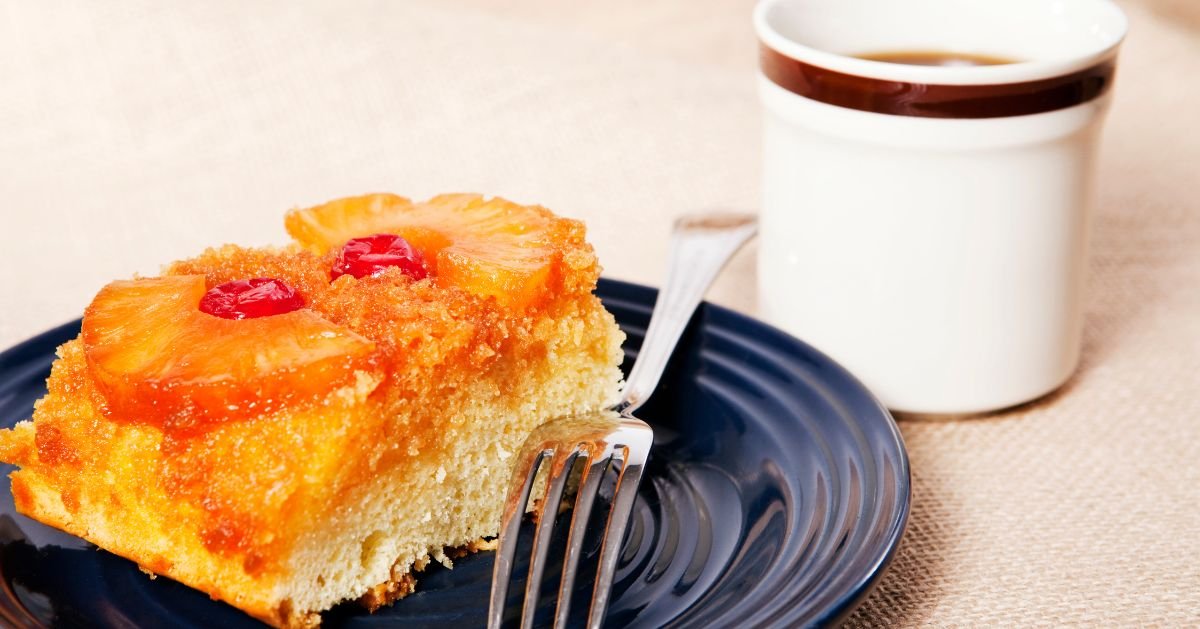Freezing cakes can be a challenge as they often contain delicate ingredients that can lose their charm when exposed to extreme cold. However, upside-down pineapple cake possesses distinct qualities. With its caramelized pineapple rings and its soft, buttery crumb, this cake has the potential to survive the icy encounter and emerge as a delightful surprise once thawed.
If you’ve just baked a delectable pineapple upside-down cake that has left your taste buds in pure bliss, you may wonder: can you freeze the upside-down cake? So, let’s embark on a culinary adventure together as we unlock the secrets of freezing pineapple upside-down cake. Get ready to discover the dos and don’ts, explore the proper storage techniques, and uncover some handy tips to maintain its irresistible appeal.
Contents
- 1 Can You Freeze Leftover Pineapple Upside-Down Cake?
- 2 How Does Freezing Affect the Texture and Taste of Cakes?
- 3 Factors to Ponder Before Freezing a Pineapple Upside-Down Cake
- 4 What Makes Pineapple Upside-Down Cake Unique?
- 5 Preserving Cake Freshness and Preventing Freezer Burn
- 6 Storage Tips for Maintaining Cake Freshness
- 7 Should the Cake Be Sliced or Portioned Before Freezing?
- 8 How Can Flash Freezing Improve the Preservation of the Cake?
- 9 Other Cake-Freezing Considerations
- 10 Conclusion
Can You Freeze Leftover Pineapple Upside-Down Cake?
Yes, you can freeze leftover pineapple upside-down cake and enjoy it later! The cake’s texture and moisture make it an excellent candidate for freezing without compromising its deliciousness. To freeze it properly, wrap individual slices or the entire cake with plastic to prevent freezer burn. Then, please place it in an airtight container or freezer-safe bag.
Thaw the cake slowly in the refrigerator when it’s time to indulge in your frozen treat. Allow it sufficient time to defrost and regain its original flavors. If you desire warmth, gently reheat it in the oven to restore its cozy temperature and delightful aroma.
To maintain quality, remember to consume the frozen cake within three to four months. By following these simple steps, you can extend the lifespan of your pineapple upside-down cake and savor its deliciousness at your convenience.
You can also read about, I Cinnamon toast crunch is vegan?
How Does Freezing Affect the Texture and Taste of Cakes?
Freezing has become quite popular in baking to extend the shelf life of various goodies, including cakes. Let us explore how freezing affects the cake.
Preserving Texture with a Chill
When cakes face freezing temperatures, something magical happens. The moisture inside the cake turns into tiny ice crystals, creating a protective shield that helps retain its moisture and tenderness. Think of freezing as the cake’s guardian, safeguarding its texture and preserving its delightful qualities even after thawing.
A Symphony of Flavors
While freezing works wonders on the texture, it also subtly impacts the taste of cakes. As the cake freezes, the flavors undergo a beautiful transformation. The low temperatures allow the ingredients to mingle and blend, resulting in a more harmonious and intensified flavor profile. It’s like a symphony of taste sensations that takes the cake to new heights of deliciousness.
The Journey of Transformation
When it’s time to bring the frozen cake back to life, a marvelous journey unfolds. As the ice crystals melt away and the cake gradually returns to its original state, its texture and taste come alive. It’s a moment of rejuvenation, where the cake reveals its true essence and invites us to indulge in its delightful flavors and heavenly texture once again.
Mastering the Art of Freezing and Thawing
To make the most of freezing, following proper techniques for freezing and thawing is essential. Before freezing:
- Protect the cake from moisture loss by using airtight wrapping or containers.
- When it’s time to thaw the cake, take it slow and steady.
- Let it gradually reach room temperature, allowing it to reconnect with the world before it’s ready to be served and savored.
Factors to Ponder Before Freezing a Pineapple Upside-Down Cake
Preserving the delightful flavors of an upside-down pineapple cake while freezing it requires some careful thought. To ensure the best results when you thaw it later, you should keep several vital factors in mind. Let’s explore these considerations in detail.
- Moisture Content: The moistness of the cake is crucial. A cake that’s too dry might become brittle and unappetizing after freezing. On the other hand, an overly moist cake can lose its structure and turn soggy upon thawing. It’s essential to find the right balance for a successful freezing process.
- Toppings and Glaze: Consider the toppings and glaze on your upside-down pineapple cake. Some toppings, like caramelized pineapple slices and sticky glazes, may be affected by freezing. While some may retain their integrity, others might become soft or lose their visual appeal. Consider how the toppings will hold up before freezing.
- Choosing the Right Storage Containers: The containers you choose for freezing play a vital role in maintaining the cake’s quality. Opt for airtight containers that prevent moisture loss and freezer burn. Avoid using containers that are too large, as excess air can lead to the formation of ice crystals, compromising the texture and flavor. Select the right size and make sure the containers seal tightly.
- Labeling and Dating: To avoid confusion and ensure the best experience upon thawing, label your frozen pineapple upside-down cake containers with the freezing date. This helps you keep track of storage duration and ensures you consume the cake within the recommended timeframe for optimal taste and texture.
- Thawing Technique: When it’s time to enjoy your frozen masterpiece, the thawing technique is crucial. Gradual thawing in the refrigerator is generally recommended to preserve the cake’s moisture and structure. Avoid rapid thawing at room temperature, as it can lead to uneven thawing and compromise the texture.
- Post-Thaw Refreshing: After thawing your upside-down pineapple cake, consider adding a touch of freshness. A light dusting of powdered sugar, a glaze drizzle, or a whipped cream dollop can revitalize the cake’s visual appeal and add an extra layer of indulgence.
What Makes Pineapple Upside-Down Cake Unique?
Pineapple Upside-Down Cake is a dessert with irresistible charm and mouthwatering appeal. Its unique presentation sets it apart: juicy pineapple rings and cherries placed at the bottom of the pan, which become a caramelized crown once the cake is baked and flipped onto a serving platter. But it’s not just about looks—this cake offers a delightful blend of flavors that dance on your taste buds.
The sweetness of caramelized pineapple perfectly complements the buttery goodness of the cake, creating a burst of tropical zest with every bite. And let’s not forget the texture! The moist cake crumb and the slightly sticky and caramelized fruit topping provide a symphony of sensations that keeps you coming back for more. Pineapple Upside-Down Cake has become a beloved classic, evoking a sense of nostalgia and warmth. It’s a dessert that transcends the ordinary, offering a truly extraordinary experience.
Preserving Cake Freshness and Preventing Freezer Burn
Proper wrapping is critical to maintaining your cake’s integrity and mouthwatering flavor. It acts as a protective shield against moisture loss, freezer burn, and unwanted odors.
Materials for Optimal Cake Wrapping
Choosing suitable materials for wrapping your cake is crucial. You can select food-grade plastic wrap, aluminum foil, or freezer-safe resealable bags. These options create a barrier that keeps air and moisture at bay, ensuring your cake remains moist and tasty.
Step-by-Step Cake Wrapping Process
- Allow the Cake to Cool: Give your cake enough time to cool down completely before you start wrapping. Wrapping a warm cake can cause condensation, leading to potential moisture-related issues.
- Prepare the Wrapping Materials: Prepare your plastic wrap, aluminum foil, or resealable bag. Make sure you have enough to fully cover the cake.
- Secure the Base: Place the cake on a sturdy, flat surface and support it with a cake board or a sturdy plate. This will keep the cake stable during the wrapping process.
- Initial Layer: Begin by gently covering the entire cake with a layer of plastic wrap. Make sure there are no gaps or exposed areas. This first layer acts as a protective shield against moisture loss.
- Second Layer: Add another layer of protection by wrapping the cake with aluminum foil. Seal it tightly to create an extra barrier against freezer burn.
- Final Enclosure: Put the double-wrapped cake inside a sealable bag that can withstand freezing. Remove any extra air from the bag, then firmly close it. This last layer provides added defense against freezer odors and moisture.
Storage Tips for Maintaining Cake Freshness
To further prolong the freshness of your cake, here are a few helpful tips:
- Temperature: Store your wrapped cake in the coldest part of the freezer, ideally at or below 0°F (-18°C). This chilly temperature will help preserve the cake’s texture and flavor.
- Avoid Frequent Thawing and Refreezing: Whenever possible, aim to thaw the entire cake at once. Frequent thawing and refreezing can compromise its quality and contribute to freezer burn.
- Label and Date: Remember to label your cake with the date of storage. This one step will enable you to keep track of its shelf life and consume it within a suitable time limit.
Should the Cake Be Sliced or Portioned Before Freezing?
Slicing the cake before freezing creates convenient individual slices ready to enjoy whenever possible. On the other hand, portioning the cake into smaller pieces offers flexibility for different appetites and dietary needs. Regardless of your chosen method, protecting the cake’s moisture is crucial by tightly wrapping each slice or portion in plastic wrap and storing them in an airtight container or freezer bag. When it’s time to thaw the cake, a gradual process in the refrigerator ensures the texture and flavors remain intact.
How Can Flash Freezing Improve the Preservation of the Cake?
Flash freezing is a game-changing technique that revolutionizes cake preservation. Subjecting cakes to ultra-low temperatures quickly prevents the formation of large ice crystals, preserving the cake’s texture, moisture, and overall quality. With flash freezing, cakes retain their humidity and velvety texture even after being stored for a while. It locks in freshness, prevents staleness, and preserves the just-baked aroma. The original flavors remain intact, ensuring each bite delights with its delicious taste.
There are different flash-freezing techniques available. Blast freezing involves using a special freezer to rapidly freeze cakes at shallow temperatures, minimizing moisture loss and crystallization. Another cutting-edge method is liquid nitrogen flash freezing, where cakes are instantly frozen using the super-cold temperatures of liquid nitrogen. This extends shelf life and adds a touch of spectacle to the experience.
Flash freezing allows us to capture the magic of cakes and keep them in suspended animation. Whether you’re a baker or a cake lover, this technique helps defy time and present cakes that emerge from freezers as pristine and delectable as the day they were made. With the power of flash freezing, cakes can be enjoyed with all their original freshness and flavors intact, providing a delightful experience with every slice.
Other Cake-Freezing Considerations
Preserving the taste and quality of cakes while freezing them requires more than just popping them into the freezer. Here are some essential factors you should keep in mind to ensure your cakes come out of the freezing process as delightful as they were before.
Icing Insight
Different types of icings or frostings can react differently to freezing. With their high-fat content, buttercream and cream cheese frostings handle freezing quite well. However, icings that contain delicate ingredients like egg whites or fresh fruits may fare less nicely. To play it safe, consider excluding these perishable elements before freezing and adding them after the cake has thawed.
Protecting the Design
If your cake is adorned with intricate decorations, sugar work, or delicate cake toppers, freezing can pose a risk to their integrity. To prevent any damage, it’s best to remove these delicate embellishments before freezing and carefully reapply them once the cake has thawed completely. This way, your cake will retain its visual appeal and remain stunning.
Timing is Key
Consider how long you plan to store the cake in the freezer. Cakes frozen for extended periods may experience some loss in flavor and texture quality. Aim to consume the frozen cake within three months to ensure the best taste and consistency. This timeframe allows you to savor your cake while enjoying its original qualities.
Preserving Cake Delights
By taking into account these additional considerations when freezing cakes, you can preserve their deliciousness and enjoy them long after they were first baked. From maintaining moisture to protecting delicate decorations, these tips will help you achieve frozen cake perfection. So go ahead, freeze confidently, and relish your favorite cakes’ flavors whenever you desire.
Conclusion
Pineapple upside-down cake can indeed be frozen without losing its delightful qualities. Freezing preserves the texture and taste of the cake, creating a protective shield of ice crystals that retain its moisture and tenderness. You can enjoy the frozen treat for up to three to four months by properly wrapping the cake and following the recommended storage techniques. Thawing the cake slowly in the refrigerator and gently reheating it in the oven can bring back its original flavors and cozy temperature.
With careful consideration of moisture content, toppings, storage containers, and labeling, you can ensure the best results when freezing an upside-down pineapple cake. Flash freezing offers a revolutionary technique to preserve cakes by rapidly freezing them, maintaining their freshness, texture, and flavors. Other factors to consider include moisture levels, types of icing, protecting decorations, and timing the storage duration. By following these guidelines, you can confidently freeze cakes and savor their deliciousness whenever you desire.















